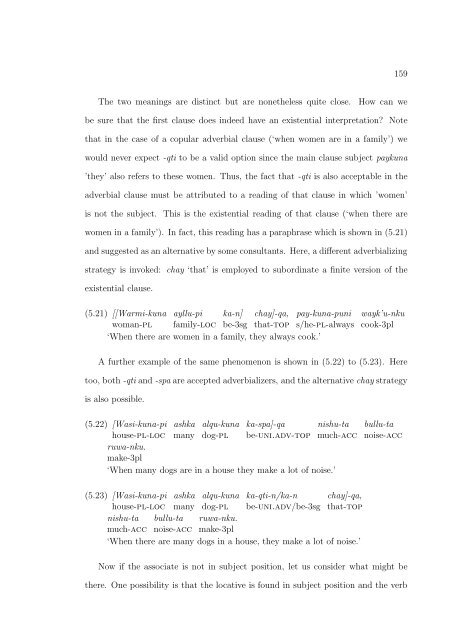the syntax and semantics of relativization and quantification
the syntax and semantics of relativization and quantification
the syntax and semantics of relativization and quantification
You also want an ePaper? Increase the reach of your titles
YUMPU automatically turns print PDFs into web optimized ePapers that Google loves.
159<br />
The two meanings are distinct but are none<strong>the</strong>less quite close. How can we<br />
be sure that <strong>the</strong> first clause does indeed have an existential interpretation? Note<br />
that in <strong>the</strong> case <strong>of</strong> a copular adverbial clause (‘when women are in a family’) we<br />
would never expect -qti to be a valid option since <strong>the</strong> main clause subject paykuna<br />
’<strong>the</strong>y’ also refers to <strong>the</strong>se women. Thus, <strong>the</strong> fact that -qti is also acceptable in <strong>the</strong><br />
adverbial clause must be attributed to a reading <strong>of</strong> that clause in which ’women’<br />
is not <strong>the</strong> subject. This is <strong>the</strong> existential reading <strong>of</strong> that clause (‘when <strong>the</strong>re are<br />
women in a family’). In fact, this reading has a paraphrase which is shown in (5.21)<br />
<strong>and</strong> suggested as an alternative by some consultants. Here, a different adverbializing<br />
strategy is invoked: chay ‘that’ is employed to subordinate a finite version <strong>of</strong> <strong>the</strong><br />
existential clause.<br />
(5.21) [[Warmi-kuna ayllu-pi ka-n] chay]-qa, pay-kuna-puni<br />
woman-pl family-loc be-3sg that-top s/he-pl-always<br />
‘When <strong>the</strong>re are women in a family, <strong>the</strong>y always cook.’<br />
wayk’u-nku<br />
cook-3pl<br />
A fur<strong>the</strong>r example <strong>of</strong> <strong>the</strong> same phenomenon is shown in (5.22) to (5.23). Here<br />
too, both -qti <strong>and</strong> -spa are accepted adverbializers, <strong>and</strong> <strong>the</strong> alternative chay strategy<br />
is also possible.<br />
(5.22) [Wasi-kuna-pi<br />
house-pl-loc<br />
ashka<br />
many<br />
alqu-kuna<br />
dog-pl<br />
ka-spa]-qa<br />
be-uni.adv-top<br />
ruwa-nku.<br />
make-3pl<br />
‘When many dogs are in a house <strong>the</strong>y make a lot <strong>of</strong> noise.’<br />
nishu-ta<br />
much-acc<br />
bullu-ta<br />
noise-acc<br />
(5.23) [Wasi-kuna-pi<br />
house-pl-loc<br />
ashka<br />
many<br />
alqu-kuna<br />
dog-pl<br />
ka-qti-n/ka-n<br />
be-uni.adv/be-3sg<br />
chay]-qa,<br />
that-top<br />
nishu-ta bullu-ta ruwa-nku.<br />
much-acc noise-acc make-3pl<br />
‘When <strong>the</strong>re are many dogs in a house, <strong>the</strong>y make a lot <strong>of</strong> noise.’<br />
Now if <strong>the</strong> associate is not in subject position, let us consider what might be<br />
<strong>the</strong>re. One possibility is that <strong>the</strong> locative is found in subject position <strong>and</strong> <strong>the</strong> verb
















